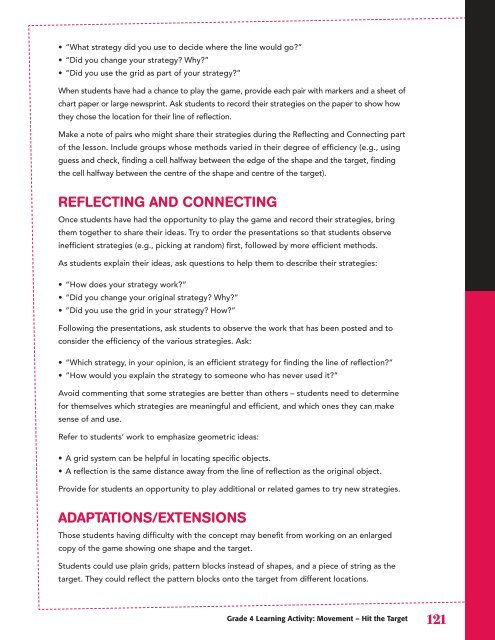Geometry and Spatial Sense, Grades 4 to 6 - EduGains
Geometry and Spatial Sense, Grades 4 to 6 - EduGains
Geometry and Spatial Sense, Grades 4 to 6 - EduGains
Create successful ePaper yourself
Turn your PDF publications into a flip-book with our unique Google optimized e-Paper software.
• “What strategy did you use <strong>to</strong> decide where the line would go?”<br />
• “Did you change your strategy? Why?”<br />
• “Did you use the grid as part of your strategy?”<br />
When students have had a chance <strong>to</strong> play the game, provide each pair with markers <strong>and</strong> a sheet of<br />
chart paper or large newsprint. Ask students <strong>to</strong> record their strategies on the paper <strong>to</strong> show how<br />
they chose the location for their line of reflection.<br />
Make a note of pairs who might share their strategies during the Reflecting <strong>and</strong> Connecting part<br />
of the lesson. Include groups whose methods varied in their degree of efficiency (e.g., using<br />
guess <strong>and</strong> check, finding a cell halfway between the edge of the shape <strong>and</strong> the target, finding<br />
the cell halfway between the centre of the shape <strong>and</strong> centre of the target).<br />
REFLECTING AND CONNECTING<br />
Once students have had the opportunity <strong>to</strong> play the game <strong>and</strong> record their strategies, bring<br />
them <strong>to</strong>gether <strong>to</strong> share their ideas. Try <strong>to</strong> order the presentations so that students observe<br />
inefficient strategies (e.g., picking at r<strong>and</strong>om) first, followed by more efficient methods.<br />
As students explain their ideas, ask questions <strong>to</strong> help them <strong>to</strong> describe their strategies:<br />
• ”How does your strategy work?”<br />
• “Did you change your original strategy? Why?”<br />
• ”Did you use the grid in your strategy? How?”<br />
Following the presentations, ask students <strong>to</strong> observe the work that has been posted <strong>and</strong> <strong>to</strong><br />
consider the efficiency of the various strategies. Ask:<br />
• “Which strategy, in your opinion, is an efficient strategy for finding the line of reflection?”<br />
• “How would you explain the strategy <strong>to</strong> someone who has never used it?”<br />
Avoid commenting that some strategies are better than others – students need <strong>to</strong> determine<br />
for themselves which strategies are meaningful <strong>and</strong> efficient, <strong>and</strong> which ones they can make<br />
sense of <strong>and</strong> use.<br />
Refer <strong>to</strong> students’ work <strong>to</strong> emphasize geometric ideas:<br />
• A grid system can be helpful in locating specific objects.<br />
• A reflection is the same distance away from the line of reflection as the original object.<br />
Provide for students an opportunity <strong>to</strong> play additional or related games <strong>to</strong> try new strategies.<br />
ADAPTATIONS/EXTENSIONS<br />
Those students having difficulty with the concept may benefit from working on an enlarged<br />
copy of the game showing one shape <strong>and</strong> the target.<br />
Students could use plain grids, pattern blocks instead of shapes, <strong>and</strong> a piece of string as the<br />
target. They could reflect the pattern blocks on<strong>to</strong> the target from different locations.<br />
Grade 4 Learning Activity: Movement – hit the Target 121

















